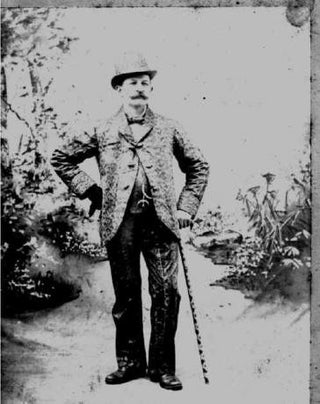Written by Sara Rising
Rattlesnake Pete, whose real name was Peter Gruber, became famous in the early 20th century for his reptilian-centric museum and saloon on Mill Street in Rochester. Patrons from far and wide would come to Pete’s for a drink and a glimpse of his famous exhibits of eccentricities , as well as his extensive collection of rattlesnakes, copperheads, adders, and other reptiles. Pete, a friendly and likeable man, made his mark in Rochester by serving up drinks alongside hundreds of curios and oddities including – but far from limited to – an Egyptian mummy, a two-headed calf, three-legged chicken, a 3,000-pound stuffed Percheron horse, tanks filled with writhing snakes, jars of pickled brains, New York’s first electric chair, a pipe said to have been smoked by John Wilkes Booth, the weight used in the last hanging in the city, the battle flag of Custer’s last stand, a shingle from the Johnstown flood, a 100-year-old harpsichord, stuffed animals and snakes of all kinds, and even an ax used by a wife murderer. Then there was the skull of the horse of Civil War General Philip H. Sheridan and $20 gold coin lying on the bar, wired to shock anyone who dared steal it.
Pete was also known for his handling of all types of snakes, especially poisonous rattlesnakes and copperheads, as well as his knowledge of their venom’s curative uses. He would advertise his medicinal offerings to customers, declaring he could “cure Felons, Carbuncles, Blood Poison and Goiter quicker than any man on earth.” Pete also asserted that he could cure a goiter by wrapping a live snake around the patient’s throat. While there is little evidence to show such methods works, many of those treated by Pete claimed to have been cured.
Rattlesnake Pete was born in in 1858 in Oil City Pennsylvania and was the eldest son of Bavarian immigrants. He took a particular interest in snakes as a young boy after meeting an old Native American woman who lived in the hills nearby his home. From the Native Americans, Pete learned how to capture snakes and how to extract their venom’s healing properties.
It was in his father’s restaurant that Pete first displayed his rattlesnake collection. He put his captures in a screen covered box for visitors to see. The snake display became an odd attraction that kept the customers coming back. After a flood and fire destroyed Oil City in 1893, Peter left his hometown to open up a saloon. He first travelled to Pittsburgh to find a location for his business, then to Jamestown and Buffalo, but was rebuffed by city officials at every turn. Peter came to Rochester by chance when he visited his sister and her husband, a Rochesterian and brewer. Soon after, Peter opened up his own establishment, calling it the “greatest curiosity in the city” on Mill Street behind the Reynolds Arcade and opposite Corinthian Hall, in Rochester’s First Ward. The neighborhood, at the time, was heavily controlled by gangs, but Pete was able to assuage any potential threats with his large stature and fearless reputation for handling poisonous snakes. 
Pete would also often go on snake hunts throughout western New York and invited friends to join. Three of these included at various times reporters Henry Clune and Charles Stilson, and well-known newspaper photographer Albert W. Stone of the Rochester Herald and Democrat and Chronicle. As Henry Clune described:
“Some farmer in the nearby countryside would see a snake in his field and report to Peter that it was a rattler. It never was. But Pete would put on a vest made of rattlesnake skins, and we would set out in his red Rambler automobile, which was ornamented in front with two large brass snakes. Occasionally, he captured a large harmless snake, but more often found no reptile of any kind. The occasion, however, made good news copy, and Pete delighted in the expansion of his reputation, and gained more goiter “patients” as the result of it. He was a friendly and likeable old fellow, and as his red Rambler with its brass symbols toured the country roads, he received welcoming shouts from all the country folk who saw him.”
Rattlesnake Pete’s spent 40 years as a snake handler, saloon owner and curator of the odd. In 1931 Pete retired due to what the Democrat and Chronicle referred to as a “combination of ailments.” Pete died in his home on Averill Avenue in 1932 at the age of 75. He is interred in Holy Sepulchre Cemetery off Lake Avenue in Rochester. The museum closed shortly after Pete’s passing and most of the remaining items were sold at auction. The Democrat and Chronicle noted Pete’s influence in the community, saying that “ . . . In his passing, Rochester loses one of its most colorful characters, a man whose unusual tastes and pursuits had given him a reputation that was actually world-wide and whose qualities of mind and sympathy of heart had endeared him to the friends whom he counted in thousands. Although he bore the name of “Rattlesnake Pete” for more than half a century, it was a foreign to the genial and humorous disposition and his unfailing kindness and courtesy as any nickname well could be.”
Sources:
They Put Rochester on the Map by Donovan Shilling, e-book.
The Biography of Rattlesnake Pete by Charles B. Stilson, Gates Historical Society, 2007.
The Story of “Rattlesnake Pete” by Joel Nickell.
